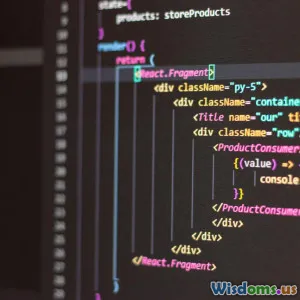
React vs Vue in 2024 Which Framework Should You Really Learn
10 min read A comprehensive comparison of React and Vue in 2024 to help you choose the right JavaScript framework. (0 Reviews)
React vs Vue in 2024: Which Framework Should You Really Learn?
Choosing the right JavaScript framework can feel like navigating a labyrinth today. With hundreds of options, two names stand out primarily for modern web projects: React and Vue. But in 2024, which of these powerhouse frameworks should you actually learn? From startups to enterprise-grade apps, React and Vue are flourishing — but both have unique attributes, communities, and learning paths that cater to different developers.
This detailed comparison doesn’t just skim the surface. We dive deep into technical differences, ecosystem maturity, career impact, real-world adoption, and learning experience to arm you with clear guidance about the modern frontend landscape.
Introduction
Since their origins, React and Vue have shaped how developers build user interfaces. React came onto the scene in 2013, backed by Facebook, and revolutionized the way UI components are built with its virtual DOM and component-driven architecture. Vue, created by Evan You around 2014, followed with a more approachable, progressive framework aimed at ease of integration and flexibility.
Today, 2024, these frameworks continue evolving. React’s ecosystem remains dominant, with a vast open-source community and enterprise adoption. Conversely, Vue emphasizes simplicity, clean integration, and growing international popularity, especially in Asia and parts of Europe.
So let’s dissect the factors around: performance, learning curve, community support, tooling, and job market applicability to understand which framework deserves your attention.
1. Overview of React and Vue
React: The Ubiquitous Giant
React functions as a JavaScript library rather than a full-fledged framework. It focuses on building UI components, leaving routing, state management, and other aspects to complementary tools (Redux, React Router, etc.). React’s core philosophy is declarative programming and unidirectional data flow, emphasizing fast rendering thanks to the virtual DOM.
Highlights:
- Developed and maintained primarily by Meta (Facebook) with massive community support.
- Rich ecosystem including React Native for mobile apps.
- Strong TypeScript integration is now native.
- JSX syntax merges JavaScript and markup, increasing flexibility but posing an initial adjustment curve.
Vue: The Progressive Framework
Vue presents itself as an approachable, incrementally adoptable framework. It analyzes common pain points in frontend dev and offers elegant defaults by combining concerns like declarative rendering, components, routing, and state management bundled together (Vue Router, Pinia).
Highlights:
- Created by one developer (Evan You), maintained by the community and corporations.
- Template-based syntax separates HTML, CSS, and JS improving readability.
- Focuses on simplicity and beginner-friendly API.
- Vue 3 accelerated performance with the Composition API, improving reusability and TypeScript compatibility.
2. Performance and Architecture
Performance is often critical in user experience. React uses a virtual DOM and reconciliation algorithms optimized by years of major app feedback (Facebook, Instagram). React’s fiber architecture enhances rendering priorities and interruption-based rendering for fluid UI updates.
Vue 3 introduced the Proxy-based reactive system, significantly speeding up rendering and change detection over Vue 2. The Composition API in Vue 3 allows developers to organize code logically, aiding maintainability.
Benchmarks and Real-world Insights:
- Independent benchmarks (e.g., js-frameworks-benchmark) generally show close results between React and Vue 3 in small to medium apps.
- React handles larger, more complex apps seamlessly due to its fiber architecture and mature ecosystem.
- Vue provides better startup performance and memory efficiency in smaller projects or rapid prototyping.
3. Learning Curve and Developer Experience
Choosing a framework also boils down to how fast and smooth your learning journey will be.
React Learning Curve
React’s JSX syntax can be a unique hurdle initially because HTML-like structures intermingle with JavaScript logic. However, for those comfortable with JavaScript ES6+ features like arrow functions, destructuring, and closures, React becomes intuitive quickly. React's ecosystem adds complexity through Redux or other state managers but this modularity might benefit advanced projects.
Vue Learning Curve
Vue provides a gentle ramp. Its Single File Components (SFCs) separate concerns (template, script, style) within the same file, making it easy especially for newcomers or those with HTML/CSS background. Moreover, Vue’s documentation is extensive, beginner-friendly, and praised for clarity.
Real Developer Insights
“Starting with Vue felt smooth—I could write meaningful components in days. React took a bit longer but once I got JSX and hooks, development became more flexible.” – Frontend Engineer at a fintech firm.
The Vue Composition API does introduce some React-like concepts, potentially narrowing the gap in experience required.
4. Ecosystem and Tooling
React boasts an incredibly rich ecosystem:
- React Router, Redux Toolkit, Next.js (for SSR and static), and React Native embolden the framework’s usability across platforms.
- Tools like Create React App and Vite streamline project initiation.
- Huge third-party libraries ensure every feature is addressable.
Vue’s ecosystem, while younger, is solid and growing:
- Vue Router and Pinia are officially recommended tools.
- Nuxt.js, the Vue counterpart to Next.js, excels in server-side rendering, static site generation, and meta management.
- Vue CLI (though Vite now preferred) supports easy scaffolding.
Both integrate well with TypeScript, but Vue’s gradual adoption of TypeScript support means React still leads in corporate TypeScript projects.
5. Community, Popularity, and Job Market
- React Stats: According to the 2023 Stack Overflow Developer Survey, React remains the most loved and used front-end library globally. Medium to large enterprises often standardize on React given its proven scalability.
- Vue Stats: Vue enjoys massive popularity in Asia, in particular China, and growing adoption in European countries and startups who prefer its productivity boost.
Job Listing Analysis (mid-2024):
- On LinkedIn and Indeed, React jobs outnumber Vue by roughly 3:1 worldwide.
- However, Vue roles command high demand in niche markets—especially for innovative startups and agencies focusing on lean development.
6. When to Choose React?
- You aim to work in large companies or fintech, e-commerce, or social network projects backed by big tech.
- You want comprehensive tooling and ecosystem maturity.
- Mobile app development across platforms with the same skillset is important (React Native).
- Embrace a JavaScript-centric framework with infinite customization potential.
7. When to Choose Vue?
- You prefer beginner-friendly frameworks or come from an HTML/CSS background.
- Your projects are smaller scale or need rapid development speed.
- You aim for startups or companies valuing developer productivity and simplicity.
- Enjoy clean separation of concerns and the flexibility of full-fledged framework bundled solutions.
Conclusion
Choosing between React and Vue in 2024 inevitably depends on your goals, background, and project requirements. React remains the powerhouse with unmatched employment opportunities and evergreen innovation pushing UI development boundaries. Vue deserves serious consideration for those who appreciate elegance, simplicity, and strong developer ergonomics.
Ultimately, both frameworks are sustainable and valuable skills. Learning either puts you on a path of modern, component-based web development enabling you to craft engaging user experiences. As Evan You said:
"The choice of a framework is a means to an end. Focus on building great things."
So assess your priorities, try both, and pick the one that resonates with your creativity and career ambitions.
Happy coding in 2024!
Rate the Post
User Reviews
Popular Posts



















